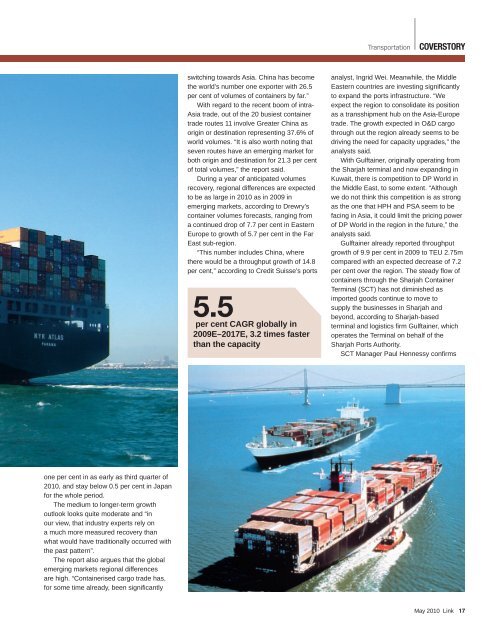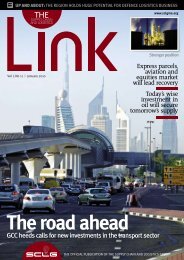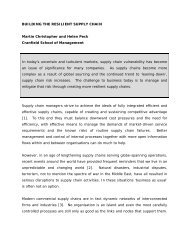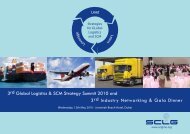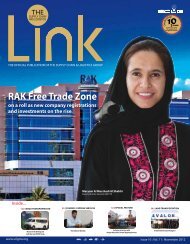Free to Download - SCLG
Free to Download - SCLG
Free to Download - SCLG
You also want an ePaper? Increase the reach of your titles
YUMPU automatically turns print PDFs into web optimized ePapers that Google loves.
Transportation<br />
COVERSTORY<br />
switching <strong>to</strong>wards Asia. China has become<br />
the world’s number one exporter with 26.5<br />
per cent of volumes of containers by far.”<br />
With regard <strong>to</strong> the recent boom of intra-<br />
Asia trade, out of the 20 busiest container<br />
trade routes 11 involve Greater China as<br />
origin or destination representing 37.6% of<br />
world volumes. “It is also worth noting that<br />
seven routes have an emerging market for<br />
both origin and destination for 21.3 per cent<br />
of <strong>to</strong>tal volumes,” the report said.<br />
During a year of anticipated volumes<br />
recovery, regional differences are expected<br />
<strong>to</strong> be as large in 2010 as in 2009 in<br />
emerging markets, according <strong>to</strong> Drewry’s<br />
container volumes forecasts, ranging from<br />
a continued drop of 7.7 per cent in Eastern<br />
Europe <strong>to</strong> growth of 5.7 per cent in the Far<br />
East sub-region.<br />
“This number includes China, where<br />
there would be a throughput growth of 14.8<br />
per cent,” according <strong>to</strong> Credit Suisse’s ports<br />
5.5<br />
per cent CAGR globally in<br />
2009E–2017E, 3.2 times faster<br />
than the capacity<br />
analyst, Ingrid Wei. Meanwhile, the Middle<br />
Eastern countries are investing significantly<br />
<strong>to</strong> expand the ports infrastructure. “We<br />
expect the region <strong>to</strong> consolidate its position<br />
as a transshipment hub on the Asia-Europe<br />
trade. The growth expected in O&D cargo<br />
through out the region already seems <strong>to</strong> be<br />
driving the need for capacity upgrades,” the<br />
analysts said.<br />
With Gulftainer, originally operating from<br />
the Sharjah terminal and now expanding in<br />
Kuwait, there is competition <strong>to</strong> DP World in<br />
the Middle East, <strong>to</strong> some extent. “Although<br />
we do not think this competition is as strong<br />
as the one that HPH and PSA seem <strong>to</strong> be<br />
facing in Asia, it could limit the pricing power<br />
of DP World in the region in the future,” the<br />
analysts said.<br />
Gulftainer already reported throughput<br />
growth of 9.9 per cent in 2009 <strong>to</strong> TEU 2.75m<br />
compared with an expected decrease of 7.2<br />
per cent over the region. The steady flow of<br />
containers through the Sharjah Container<br />
Terminal (SCT) has not diminished as<br />
imported goods continue <strong>to</strong> move <strong>to</strong><br />
supply the businesses in Sharjah and<br />
beyond, according <strong>to</strong> Sharjah-based<br />
terminal and logistics firm Gulftainer, which<br />
operates the Terminal on behalf of the<br />
Sharjah Ports Authority.<br />
SCT Manager Paul Hennessy confirms<br />
one per cent in as early as third quarter of<br />
2010, and stay below 0.5 per cent in Japan<br />
for the whole period.<br />
The medium <strong>to</strong> longer-term growth<br />
outlook looks quite moderate and “in<br />
our view, that industry experts rely on<br />
a much more measured recovery than<br />
what would have traditionally occurred with<br />
the past pattern”.<br />
The report also argues that the global<br />
emerging markets regional differences<br />
are high. “Containerised cargo trade has,<br />
for some time already, been significantly<br />
May 2010 Link 17


